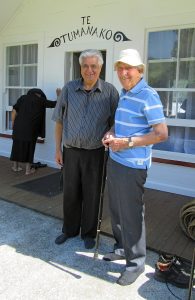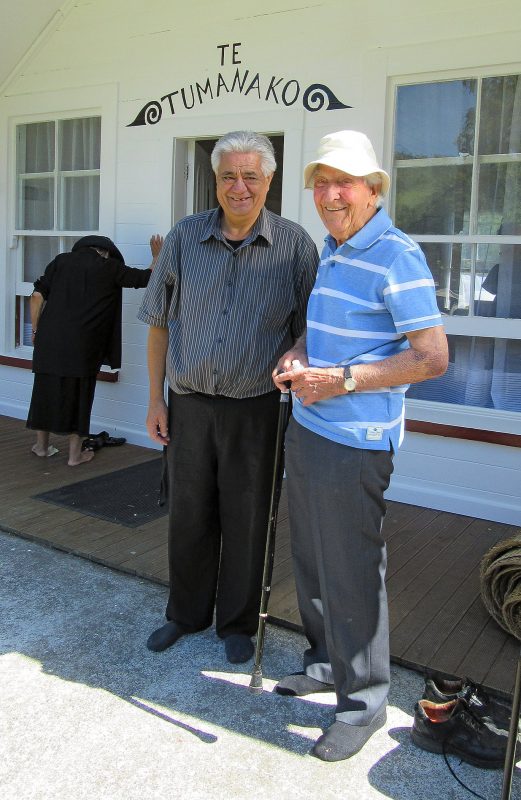by SUE SECONI
Te Tumanako Whare (sleeping, meeting and ancestral house) on Te Pou o Rongo Marae at Ranana, 50 kilometres inland along the banks of the Whanganui River, celebrated its centenary on January 23-24.

Fr Steve Hancy from Whanganui, left, and Fr Colin Durning from Wellington before the blessing of the whare.
To mark the occasion, the whare had a makeover and was formally blessed by Fr Steve Hancy from Whanganui and Fr Colin Durning from Wellington. Apart from the installation of electric lighting, the building remains almost original. The original wrought iron red roof is still in excellent condition, along with the foundation piles. Some exterior weatherboards needed replacing, along with parts of the wooden verandah that hadn’t stood the test of time.
“The maihi (arms) that rise on either side to the cross at the centre front of the roof were rotten and had to be carefully replaced. Painting inside and outside of the whare was as near as possible to the first colours,” said Tim Tapa, co-chairman with Peter Maraku, of the Pou o Rongo marae committee.
The Ruaka Hapu Marae kitchen, situated above Te Pou o Rongo, will also get a complete makeover, after the marae won $70,000 worth of kitchen equipment when named Marae Kai Masters Winners 2015 on the Maori TV cooking series.
Southern Hospitality Ltd sponsored this cooking challenge between different marae.
The whanau team of Rawiri Tinirau (treasurer of the marae) his dad John Hamlin, sister Rongomaiwahine Hamlin and brother Tumanako Tinirua could have lost in their first effort because they forgot to make the blackberry sauce to accompany the venison in time for it to rest and therefore allow the flavours to sweeten.
Tumanako, a reputable baker in his own right, developed New Zealand’s first glutenfree croissant.
However, their meal cooked for 40 whanau on their own marae impressed the judges and they were on their way to the semi-finals and finals, which were held in Auckland over three consecutive weekends.
“We had to cook dishes catering for 120 people using ancestral foods such as duck, seafood, herbs, eel and the Chatham Island weka, which were all provided. However we weren’t allowed to use modern foods such as oil or sugar, but could use modern appliances. The dessert was a panna cotta,” Mr Tinirau said.
A lasting memory from the experience was the people they met, especially the other ringawera (kitchen hands) from marae around New Zealand.
“They are fantastic people, doing great things for their marae and there were more similarities than differences across the competing teams,” he said.
The experience isn’t unlike what is seen on other cooking competition programmes on other television channels. “What can’t be televised is the whanaungatanga (kinship), aroha (love) and genuine sharing and caring from everyone involved,” Mr Tinirau said.
Before their new appliances are installed, including a commercial top-of-the range gas top with electric convection oven, dishwasher, shelving and workbenches, the 60-year-old kitchen requires an upgrade. The marae has applied for a lottery grant and, if this money is secured, the alterations can begin, with Southern Hospitality Ltd assisting to see the project through to completion.
Ruaka Marae was honoured in August 2014 when it was chosen as the venue for the signing of the deed of settlement of the Treaty of Waitangi claims between the Crown and iwi.
Treaty Negotiations Minister Chris Finlayson, Maori King Tuheitia Paki and Ngati Tuwharetoa paramount chief Sir Tumu Te Heuheu were present for that occasion.

Reader Interactions